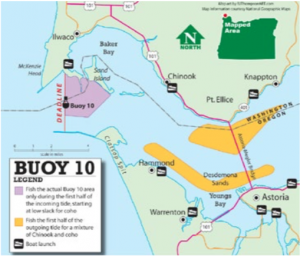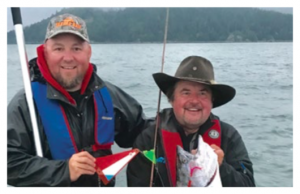Catching Salmon At “Buoy 10”
RESEARCHED, TESTED, PROVEN, AND FREE ADVICE FROM THE EXPERTS
When it comes to salmon fishing in the Pacific Northwest, it’s the Columbia River that produces the most for sport anglers. And, of the three major runs of salmon returning to the Columbia, it’s the fall run that can number a million strong and draw anglers from around the globe to share in the bounty. Just inside the Columbia River mouth, often referred to as “Buoy 10”, is where you can catch a limit of hard-fighting salmon fresh in from the Pacific Ocean. The season runs during August and September.
All five species of salmon are big, with Chinook and Coho likely the ones you’ll catch at “Buoy 10”. Coho salmon, which average 7-to- 9 pounds, must be of hatchery origin to keep – recognized by their missing adipose fin. Chinook come in all sizes with the average being 15-to-25 pounds with some dipping the scale past the 50-pound mark.
The red number ten navigation marker is the western boundary of the fishery management zone known as “Buoy 10”. Realize the waters just west of the number ten buoy, known as the Columbia River Control Zone, are closed to sport fishing. While “Buoy 10” marks the western boundary, the eastern boundary extends from the navigation light at Oregon’s Tongue Point through red channel marker 44 and on to Rocky Point on the Washington shore. This fourteen-mile section is where the fall salmon stage before starting their upriver journey.
Daily tides play a huge role in where salmon can be found at “Buoy 10” and when they might bite best. This report features advice on what to use, where you need to be and when to catch salmon.
NEAR THE NUMBER TEN BUOY
The tidal zone just east of the number ten buoy and an imaginary North/ South line extending from it is the first place you can ambush salmon entering the Columbia River. From low slack tide through the first half of the flood is when this area produces best for mostly Coho Salmon. If you arrive at low tide and find little or no current, try a forward troll. Once the tide starts to flood in, you should begin trolling into the current. The idea is to hold your position (with the bow of your boat facing west) to intercept fish moving into the Columbia with the flooding water. When the bite starts, meaning a school of salmon has moved in, try moving east with them by throttling back on your motor such that your boat will back upstream while continuing to troll into the current.
While the flood tide will reverse the flow of the Columbia, keep in mind that ocean water, being cooler and denser than that of the river, floods in underneath the surface layer of water. This is the most noticeable the nearer you are to the western boundary and during times when tides are big. For example, once the flood tide begins its big push, you may think you’ve hooked a 100-pound salmon if you put out more than 30 feet of line. What’s got hold of your outfit is not a giant salmon but the powerful current flooding in underneath the lighter, warmer surface layer of water. If you turn up the sensitivity on your fish finder you can often see a horizontal line where the surface water and cool underwater currents meet.
TROLL UPSTREAM ON THE FLOOD TIDE
While backing upstream with your bow facing westward may keep you moving east with a school of salmon while a big tide is rushing in, and you may hold your boat steady while facing into the current for a time, once the flood tide starts to fade you should consider switching directions and begin an upstream troll. This is when many seasoned anglers will switch from using a diver to a conventional weight set up.
According to “Buoy 10” guide Terry Mulkey, 503-803-1896, when trolling with the flood tide, the water will push a diver making it difficult to control its dive, which is why he switches to 12-to-16 ounce cannon-ball style sinkers suspended off a weight dropper line when upstream trolling with a flooding tide. You should realize divers will work OK while trolling east if you do so in water less than 20 feet deep. A popular area for this is along the north side of Desdemona Sands.
TROLL DOWNSTREAM ON THE OUTGOING TIDE
If your upstream troll takes you to the bridge or above you can forward troll when the tide goes slack but should begin a downstream troll as the tide begins to ebb (run out). You should realize that many thousands of salmon, after riding in on the flood tide, can hold in the North and South Channel adjacent to Desdemona Sands. Desdemona Sands is the large sand island located in the middle of the river, which extends above and below the Astoria-Megler Bridge. This area, from high-slack-tide through the first-half-of-the-ebb (run out) will likely represent the hottest bite of the day. What most anglers do is troll downstream, going with the flow of the tide, parallel to the island in 20-to-30 feet of water with a herring or spinner rigged five feet behind a diving planer and flasher. Since Chinook like to hug bottom, it’s important to keep your gear working within a few feet of bottom if you’re looking for a big boy. If you’re targeting Coho, try running your outfit at mid depth or move into shallow water, say 12-to-20 feet deep.
DIVERS
Diving planers like a Delta or Deep Six are popular at Buoy 10. The advantage of using a diver over traditional sinkers is that they trip upon the strike, which relieves the pull associated with the dive and allow you to fight your fish nearly weight free. Because their color attracts fish, you should try different diver finishes to see which ones produce best.
Most divers, regardless of brand, will dive approximately one foot for every two feet of line out. You can judge trolling depth by counting the number of line pulls off your reel. One pull of line (average distance from reel to first rod guide) should equal about two feet of line and yield one foot of dive; for example, 12 pulls equals 12 feet of dive. The exact depth will vary depending on line diameter, trolling speed, and diver size; however, counting line pulls is close enough for most situations. Of course, employing a line-counter reel will eliminate all the counting and immediately reveal the amount of line out.
FLASHERS
Flashers, like Big Al’s Fish Flash®, are popular at “Buoy 10” because they attract fish by producing horizontal, strobe-like flashes of light as they spin. Fish Flash attracts fish without the drag associated with other flasher or dodger types. The Fish Flash triangular shape and wings that extend outward make it work when attached directly to your diver or behind a Free Sliding Spreader.
FREE SLIDING SPREADER & RIGGING WIRES
Employing Yakima Bait’s Free Sliding Spreader in combination with Yakima Bait’s .051 thick stainless steel Rigging Wires makes assembling your gear fast and, should you get a tangle, makes untangling lines much faster than an all monofilament set up. Rigging wires are best used to replace monofilament as your weight-dropper line and connected to the trailing end of your flasher. (See diagram)
RODS, REELS AND LINE
A popular rod series for fishing “Buoy 10” are the Berkley Air rods. Best rod actions include the 7’9” HB and 8’ XHB, 9’ and 10’6” XH, and 9’6” and 10’6” HH(HeavyHerring)models.The7’9”and8’XHBareeasiertostowthanlonger rods and perfect for fishing straight behind your boat. The 9’ to 10’6” length rods are handy when wanting to spread lines out for a wider trolling swath. The HB and HH will handle weight up to 12-ounces; while the XHB and XH will handle 16-ounces of weight. If you’re a 20-ounce person try the 9’XH model. For reels, consider the Garcia 5500/6500 or Penn Warefare Line Counter models filled with 25-pound test Big Game monofilament or 50 to 65-pound test Berkley Braid or Spiderwire.
HERRING
Herring is the most popular bait type at “Buoy 10” and is available in different sizes (identified by the color of the package label) with Green or Blue label being the most popular. Try rigging your herring on a 4 to 6-foot leader consisting of two 4/0 or 5/0 single hooks like those made by Owner® snelled in tandem.
Fishing Tip: When using herring, it’s important to not move your rod when a salmon starts mouthing your bait. The initial bite may be so light, in fact, you might think your gear is rubbing bottom; don’t move your rod! Let the fish mouth your bait and pull your rod tip down three-to-four times before setting the hook.
SPINNERS
Spinners produce salmon just as well and sometimes better than herring, especially in the upper bay – upstream from Hammond, with the larger sizes (like a Toman Cascade or Mulkey Squid spinner) usually best for Chinook. If you are targeting Coho salmon, try a smaller size Toman, Mulkey, Hildebrandt, or trolling model of the Flash Glo spinner. Spinners rigged with squid over the hook can add to their effectiveness and are available from the factory in the above models. The most popular spinner color is Red & White but other colors, like Chartreuse/Green Dot and Mexican Flag work too.
Rigging Tip: Positioning a swivel halfway down your leader or end of your rigging wire will reduce or eliminate leader twist associated with fishing a spinner or spinning bait.
WORDS TO THE WISE
It’s your responsibility to know where the shipping lanes are located and get out of the way well in advance of freighters that regularly pass through this area. If you don’t, you could receive a ticket from the United States Coast Guard! Wearing a life jacket is a good idea at “Buoy 10” where fog, rough water, strong currents, and sometimes crowded conditions can contribute to the possibility of an accident. Since wearing a bulky life jacket can be uncomfortable, consider one of the inflatable life jackets.
 Although not a guide, Buzz is considered a sport fishing authority for salmon, steelhead, and trout. He writes a regular outdoor column in several Northwest publications, is a seminar speaker and has appeared on many TV fishing shows. He is a hall-of-famer for The Association of Northwest Steelheaders and The National Fresh Water Fishing Hall of Fame. Berkley offers a line of Buzz Ramsey
Although not a guide, Buzz is considered a sport fishing authority for salmon, steelhead, and trout. He writes a regular outdoor column in several Northwest publications, is a seminar speaker and has appeared on many TV fishing shows. He is a hall-of-famer for The Association of Northwest Steelheaders and The National Fresh Water Fishing Hall of Fame. Berkley offers a line of Buzz Ramseydesigned “Air” fishing rods designed for salmon and steelhead. Currently, Buzz is Brand Manager for Yakima Bait Company and a member of the management team.





